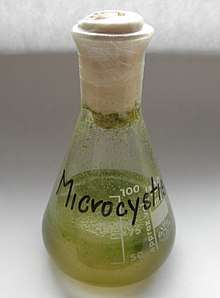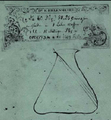Erlenmeyer flask
An Erlenmeyer flask, also known as a conical flask (British English)[1] or a titration flask, is a type of laboratory flask which features a flat bottom, a conical body, and a cylindrical neck. It is named after the German chemist Emil Erlenmeyer (1825–1909), who created it in 1860.[2]
.jpg)
Erlenmeyer flasks have wide bases, with sides that taper upward to a short vertical neck. They may be graduated, and often spots of ground glass or enamel are used where they can be labeled with a pencil. It differs from the beaker in its tapered body and narrow neck.[3] Depending on the application, they may be constructed from glass or plastic,[4] in a wide range of volumes.[5]
The mouth of the Erlenmeyer flask may have a beaded lip that can be stopped or covered. Alternatively, the neck may be fitted with ground glass or other connector for use with more specialized stoppers or attachment to other apparatus. A Büchner flask is a common design modification used for filtration under vacuum.
Uses
Use in chemistry
The slanted sides and narrow neck of this flask allow the contents of the flask to be mixed by swirling, without risk of spillage, making them suitable for titrations by placing it under the buret and adding solvent and the indicator in Erlenmeyer flask.[6] Such features similarly make the flask suitable for boiling liquids. Hot vapor condenses on the upper section of the Erlenmeyer flask, reducing solvent loss. Erlenmeyer flasks' narrow necks can also support filter funnels.
The final two attributes of Erlenmeyer flasks make them especially appropriate for recrystallization. The sample to be purified is heated to a boil, and sufficient solvent is added for complete dissolution. The receiving flask is filled with a small amount of solvent, and heated to a boil. The hot solution is filtered through a fluted filter paper into the receiving flask. Hot vapors from the boiling solvent keep the filter funnel warm, avoiding the premature crystallization.
Like beakers, Erlenmeyer flasks are not normally suitable for accurate volumetric measurements. Their stamped volumes are approximate within about 5% accuracy.[7]
Use in biology

Erlenmeyer flasks are also used in microbiology for the preparation of microbial cultures. Erlenmeyer flasks used in cell culture are sterilized and may feature vented closures to enhance gas exchange during incubation and shaking. The use of minimal liquid volumes, typically no more than one fifth of the total flask volume, and baffles molded into the flask's internal surface both serve to maximize gas transfer and promote chaotic mixing when the flasks are orbitally shaken. The oxygen transfer rate in Erlenmeyer flasks depends on the agitation speed, the liquid volume, and the shake-flask design.[8] The shaking frequency has the most significant impact on oxygen transfer.[9]
Oxygenation and mixing of liquid cultures further depend on rotation of the liquid "in-phase", meaning the synchronous movement of the liquid with the shaker table. Under certain conditions the shaking process leads to a breakdown of liquid motion – called "out-of-phase phenomenon". This phenomenon has been intensively characterized for shake flask bioreactors. Out-of-phase conditions are associated with a strong decrease in mixing performance, oxygen transfer, and power input. Main factor for out-of-phase operation is the viscosity of the culture medium, but also the vessel diameter, low filling levels and/or a high number of baffles.[10][11][12]
Legal restriction
To impede illicit drug manufacturers, the state of Texas previously restricted the sale of Erlenmeyer flasks to those who have the requisite permits.[13] On September 1, 2019, SB 616 amended the law so that permits are no longer required, but accurate inventory of this and certain other pieces of lab equipment must still be maintained, loss or theft must still be reported, and the owner must still allow audits of their records and equipment to be made.[14]
See also
Additional Images
 Original drawing of the Erlenmeyer flask
Original drawing of the Erlenmeyer flask Different styles Erlenmeyer flasks
Different styles Erlenmeyer flasks Different sizes of Erlenmeyer flask
Different sizes of Erlenmeyer flask Autoclaved sterile Erlenmeyer flasks covered with aluminium foil
Autoclaved sterile Erlenmeyer flasks covered with aluminium foil
References
- Andrea Sella (July 2008). "Classic Kit: Erlenmeyer flask". Royal Society of Chemistry..
- Emil Erlenmeyer, "Zur chemischen und pharmazeutischen Technik," Zeitschrift für Chemie und Pharmacie, vol. 3 (January 1860), 21-22. He wrote that he first displayed the new flask at a pharmaceutical conference in Heidelberg in 1857, and that he had arranged for its commercial production and sale by local glassware manufacturers.
- Laboratory Glassware. 17 November 2011
- Laboratory Flasks Information. 15 July 2016
- Volumetric Glassware. 15 July 2016
- "Method of titration". www.sciencebuddies.org/. Retrieved 2016-07-08.
- "Erlenmeyer Flasks and Beakers". www.dartmouth.edu. Archived from the original on 2016-06-16. Retrieved 2016-06-17.
- Soccol CR, Pandey A, Larroche C (2013). Fermentation Processes Engineering in the Food Industry. CRC Press Taylor & Francis Group, Florida. ISBN 978-1439887653.
- Schiefelbein S, Fröhlich A, John GT, Beutler F, Wittmann C, Becker J (2013): "Oxygen supply in disposable shake-flasks: prediction of oxygen transfer rate, oxygen saturation and maximum cell concentration during aerobic growth". Biotechnology Letters. 35 (8): 1223-30, doi:10.1007/s10529-013-1203-9, PMID 23592306.
- Kloeckner W, Diederichs S and Buechs J (2014): "Orbitally Shaken Single-Use Bioreactors". Adv Biochem Eng Biotechnol. 138: 45-60, PMID 23604207
- Buechs J, Maier U, Mildbradt C et al. (2000b): "Power consumption in shaking flasks on rotary shaking machines: II. Nondimensional description of specific power consumption and flow regimes in unbaffled flasks at elevated liquid viscosity". Biotechnol Bioeng. 68(6): 594-601, PMID 10799984
- Buechs J, Lotter S, Mildbradt C (2001b): " Out-of-phase operating conditions, a hitherto unknown phenomenon in shaking bioreactors". Biochem Eng J. 7(2): 135-141, PMID 11173302
- "TxDPS - Laws and Regulations". www.dps.texas.gov. Retrieved 2020-01-01.
- "TxDPS - News and Updates". www.dps.texas.gov. Retrieved 2020-01-01.
| Wikimedia Commons has media related to Erlenmeyer flask. |